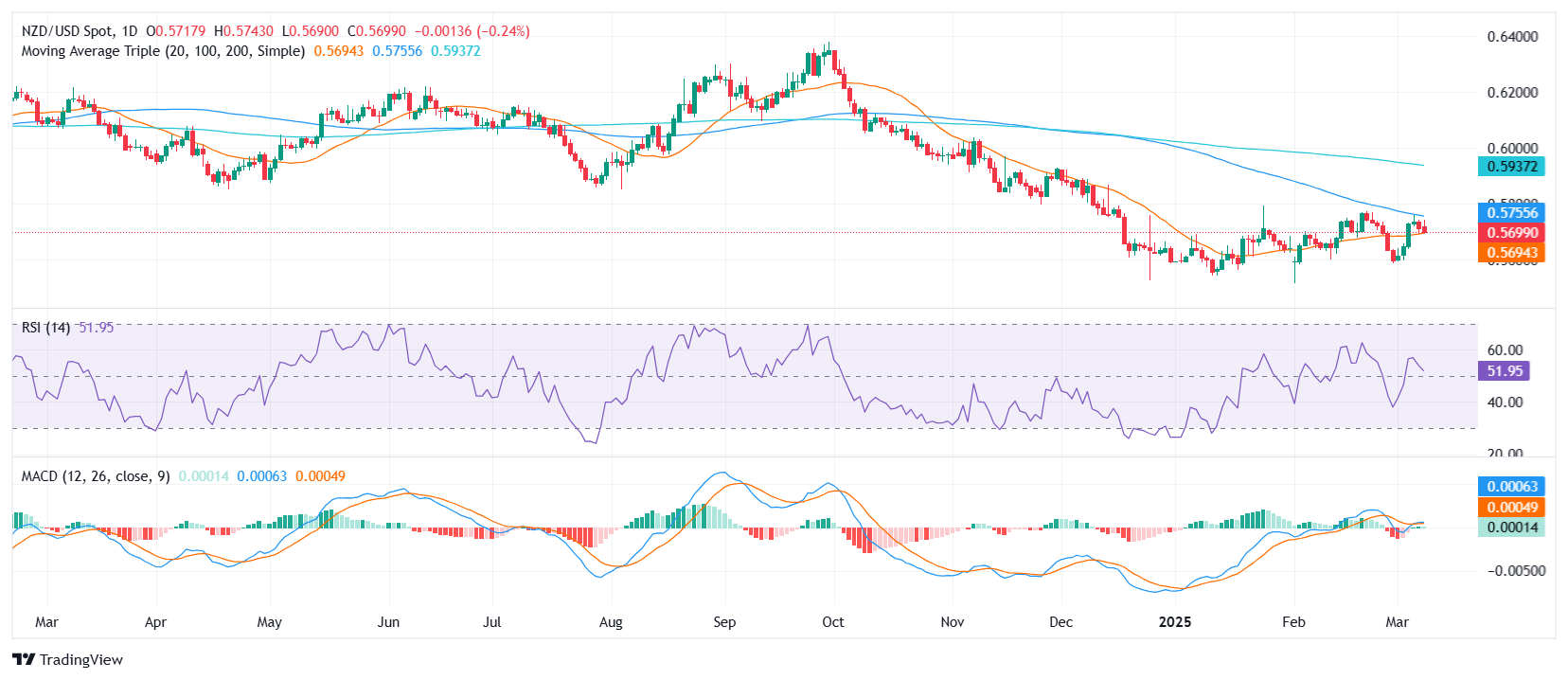- Analytics
- News and Tools
- Quotes
- Chart and quotes for NZDUSD
CFD Trading Rate New Zealand Dollar vs US Dollar (NZDUSD)
| Date | Rate | Change |
|---|
Related news
-
12.03.2025 02:05NZD/USD remains subdued near 0.5700 ahead of US CPI data
- NZD/USD struggles amid broad risk aversion, driven by policy shifts from US President Donald Trump.
- The New Zealand Dollar faces headwinds as deflationary pressures in China deepen, weighing on market sentiment.
- Headline US CPI inflation is expected to ease in February after picking up momentum in January.
NZD/USD edges lower after registering gains in the previous session, trading around 0.5710 during the Asian hours on Wednesday. The pair faces headwinds amid broad risk aversion, driven by policy shifts by US President Donald Trump, particularly tariffs that increased the likelihood of a prolonged trade war.
On data front, Electronic card transactions in New Zealand rose by 0.3% to NZD 6,528 million on a seasonally adjusted basis in February 2025. Consumables saw a 0.6% increase, while apparel gained 1%. Fuel remained unchanged, showing no significant movement.
Additionally, the New Zealand Dollar (NZD) faces headwinds as deflationary pressures in China intensify. February saw the steepest decline in consumer prices in 13 months, alongside the 29th consecutive monthly drop in factory-gate prices. Given China’s role as New Zealand’s largest trading partner, these developments have dampened market sentiment.
However, the downside of the NZD/USD pair may be limited as the US Dollar (USD) faces headwinds amid concerns over a potential economic slowdown in the United States (US). US President Donald Trump described the economy as being in a "transition period," which investors interpreted as an early sign of possible turbulence ahead.
With the Federal Reserve in its blackout period ahead of the March 19 meeting, central bank commentary will be minimal this week. Traders are shifting their focus to February’s US Consumer Price Index (CPI) release on Wednesday for further insights into inflation trends.
New Zealand Dollar PRICE Today
The table below shows the percentage change of New Zealand Dollar (NZD) against listed major currencies today. New Zealand Dollar was the weakest against the US Dollar.
USD EUR GBP JPY CAD AUD NZD CHF USD 0.10% 0.09% 0.10% 0.02% 0.10% 0.11% 0.04% EUR -0.10% -0.01% -0.03% -0.08% -0.01% 0.02% -0.05% GBP -0.09% 0.01% 0.02% -0.07% 0.00% 0.02% -0.05% JPY -0.10% 0.03% -0.02% -0.09% -0.01% 0.00% -0.05% CAD -0.02% 0.08% 0.07% 0.09% 0.08% 0.10% 0.03% AUD -0.10% 0.00% -0.00% 0.00% -0.08% 0.02% -0.04% NZD -0.11% -0.02% -0.02% -0.00% -0.10% -0.02% -0.06% CHF -0.04% 0.05% 0.05% 0.05% -0.03% 0.04% 0.06% The heat map shows percentage changes of major currencies against each other. The base currency is picked from the left column, while the quote currency is picked from the top row. For example, if you pick the New Zealand Dollar from the left column and move along the horizontal line to the US Dollar, the percentage change displayed in the box will represent NZD (base)/USD (quote).
-
11.03.2025 21:43NZD/USD Price Analysis: Kiwi defends key support but face resistance
-
11.03.2025 09:46NZD/USD: Unlikely to break the strong support level at 0.5660 – UOB Group
-
11.03.2025 09:13NZD/USD Price Forecast: Holds position above 0.5700 near 50-day EMA support
-
11.03.2025 03:48NZD/USD remains below 0.5700 as deflationary pressures deepen in China
-
10.03.2025 22:03NZD/USD Price Analysis: Bears test key support as downside risks grow
-
10.03.2025 09:59NZD/USD: Slight increase in downward momentum – UOB Group
-
10.03.2025 07:32NZD/USD edges higher to near 0.5750 despite weakened risk sentiment
-
10.03.2025 03:07NZD/USD softens to near 0.5700 on China's deflationary pressures
-
07.03.2025 10:15NZD/USD: Set to trade in a range of 0.5710/0.5760 – UOB Group
-
07.03.2025 07:44NZD/USD Price Forecast: Could retest 0.5700 support near 50-day EMA
-
07.03.2025 02:39NZD/USD remains below 0.5750 ahead of China’s trade balance
-
06.03.2025 10:44NZD/USD can rise further – UOB Group
-
06.03.2025 10:29NZD/USD refreshes weekly high near 0.5750 as China promises additional stimulus
-
06.03.2025 02:32NZD/USD rises to near 0.5750 as US Dollar softens amid improved risk sentiment
-
05.03.2025 21:25NZD/USD Price Analysis: Bulls take control as momentum shifts higher
-
05.03.2025 11:11NZD/USD gains to near 0.5680 as US Dollar continues to underperform
-
05.03.2025 10:23NZD/USD: Orr resigns from his position in the RBNZ – BBH
-
05.03.2025 09:53NZD/USD: A slim chance of NZD reaching 0.5565 – UOB Group
-
05.03.2025 02:29NZD/USD trades flat around 0.5650 despite upbeat China Services PMI, Governor Orr resigns
© 2000-2025. All rights reserved.
This site is managed by Teletrade D.J. LLC 2351 LLC 2022 (Euro House, Richmond Hill Road, Kingstown, VC0100, St. Vincent and the Grenadines).
The information on this website is for informational purposes only and does not constitute any investment advice.
The company does not serve or provide services to customers who are residents of the US, Canada, Iran, The Democratic People's Republic of Korea, Yemen and FATF blacklisted countries.
Making transactions on financial markets with marginal financial instruments opens up wide possibilities and allows investors who are willing to take risks to earn high profits, carrying a potentially high risk of losses at the same time. Therefore you should responsibly approach the issue of choosing the appropriate investment strategy, taking the available resources into account, before starting trading.
Use of the information: full or partial use of materials from this website must always be referenced to TeleTrade as the source of information. Use of the materials on the Internet must be accompanied by a hyperlink to teletrade.org. Automatic import of materials and information from this website is prohibited.
Please contact our PR department if you have any questions or need assistance at pr@teletrade.global.




















